FGC Tournament Circuit 2025: Key Events, Titles, and Highlights
Updated On: November 29, 2025 by Aaron Connolly
Overview of the FGC Tournament Circuit 2025
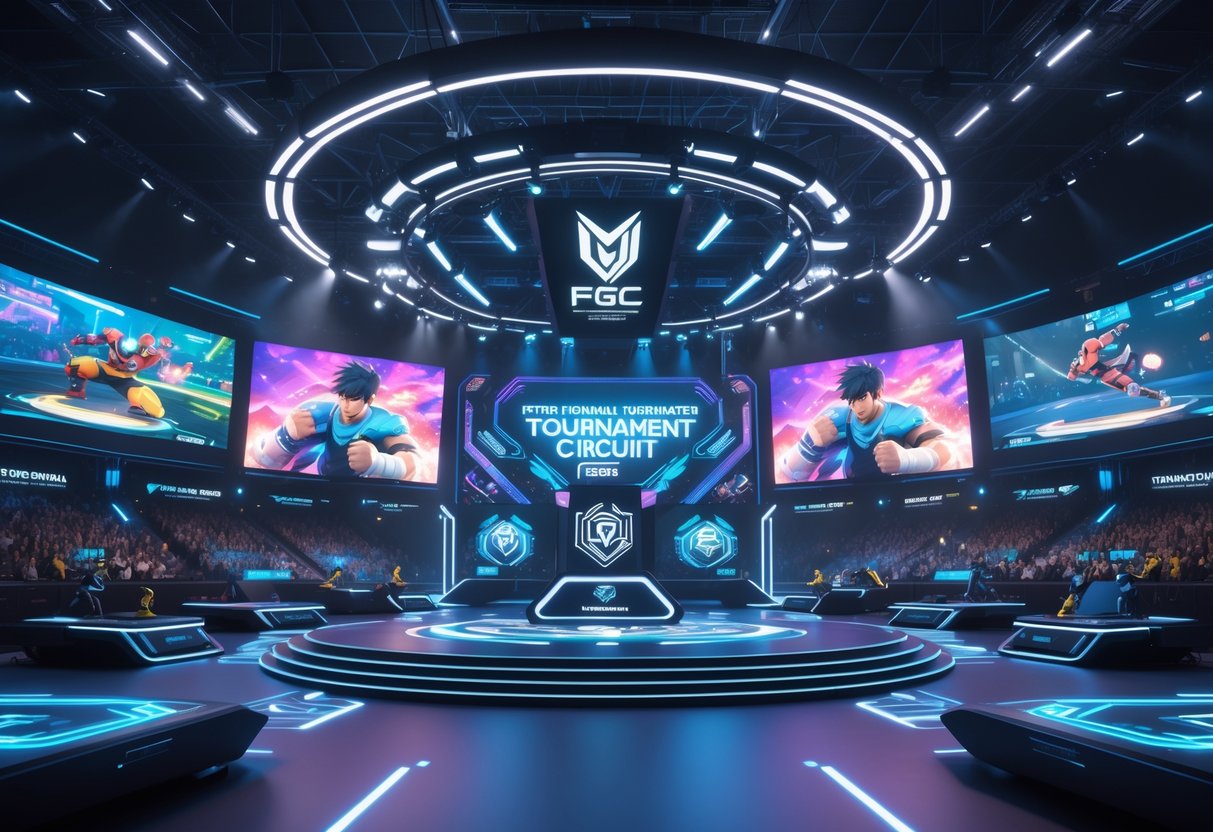
The FGC tournament circuit in 2025 blends grassroots events with major developer-backed competitions across a bunch of games. This year feels like a real turning point—new publishers are jumping in, but the old-school tournaments still keep that community vibe alive.
Structure and Format of the 2025 Circuit
You’ll find three main tiers in the 2025 FGC circuit. Major tournaments like EVO and CEO sit at the top, pulling in players from all over the world and handing out the biggest prize pools.
Regional qualifiers lead up to these majors. Local scenes are still running weekly tournaments, giving players a place to sharpen their skills and rack up ranking points.
EVO 2025 holds its spot as the world’s biggest fighting game tournament. Las Vegas hosts the event, featuring everything from Street Fighter 6 to classics like Marvel vs. Capcom 2.
CEO 2025 is set for June 13-15 at the Rosen Shingle Creek in Orlando. The spotlight’s mostly on Street Fighter 6, Tekken 8, and Guilty Gear Strive.
Most events stick with double-elimination brackets. Players start in pools and fight their way to the top cuts. Prize money? It’s all over the place—majors can offer hundreds of thousands, but your local might just hand out a couple hundred pounds.
Defining the FGC Ecosystem
The fighting game community does things its own way, pretty different from other esports. Grassroots passion really fuels most events, not big companies.
Tournament organisers often pay out of pocket to make events happen. Players will travel halfway across the world for a shot at glory, even when the prize pools are tiny. That’s helped build a close-knit, competitive scene that cares more about the games than the money.
Developer support? It’s all over the map. Capcom backs Street Fighter 6, but Nintendo actually limits Super Smash Bros. tournaments. Bandai Namco’s been pouring resources into Tekken scenes in places that never had much support before.
The FGC covers a wild mix of franchises:
- Traditional 2D fighters: Street Fighter, King of Fighters
- 3D fighters: Tekken, Soul Calibur
- Platform fighters: Super Smash Bros., Brawlhalla
- Team-based: Dragon Ball FighterZ, the new 2XKO
Growth Trends in Fighting Game Esports
Fighting game viewership is still way behind other esports. Capcom Cup X peaked at 311,610 viewers, while League of Legends Worlds pulled in a jaw-dropping 6.94 million.
Riot Games’ 2XKO might shake things up. Riot brings serious marketing muscle and a structured approach that fighting games haven’t really had before.
New releases now come packed with accessibility features. Street Fighter 6’s Modern Controls make things way easier for new players. Tekken 8 has some of the best tutorials I’ve ever seen.
Regional expansion is happening fast in 2025. Bandai Namco’s push into Africa and South America has brought some surprise stars onto the big stages. This shift is drawing fresh audiences to tournaments.
Developer support makes a huge difference. Officially backed games like Street Fighter and Tekken hand out seven-figure prize pools. Community-run games? They’re still struggling to scrape together enough cash and keep things consistent.
Featured Fighting Game Titles in 2025
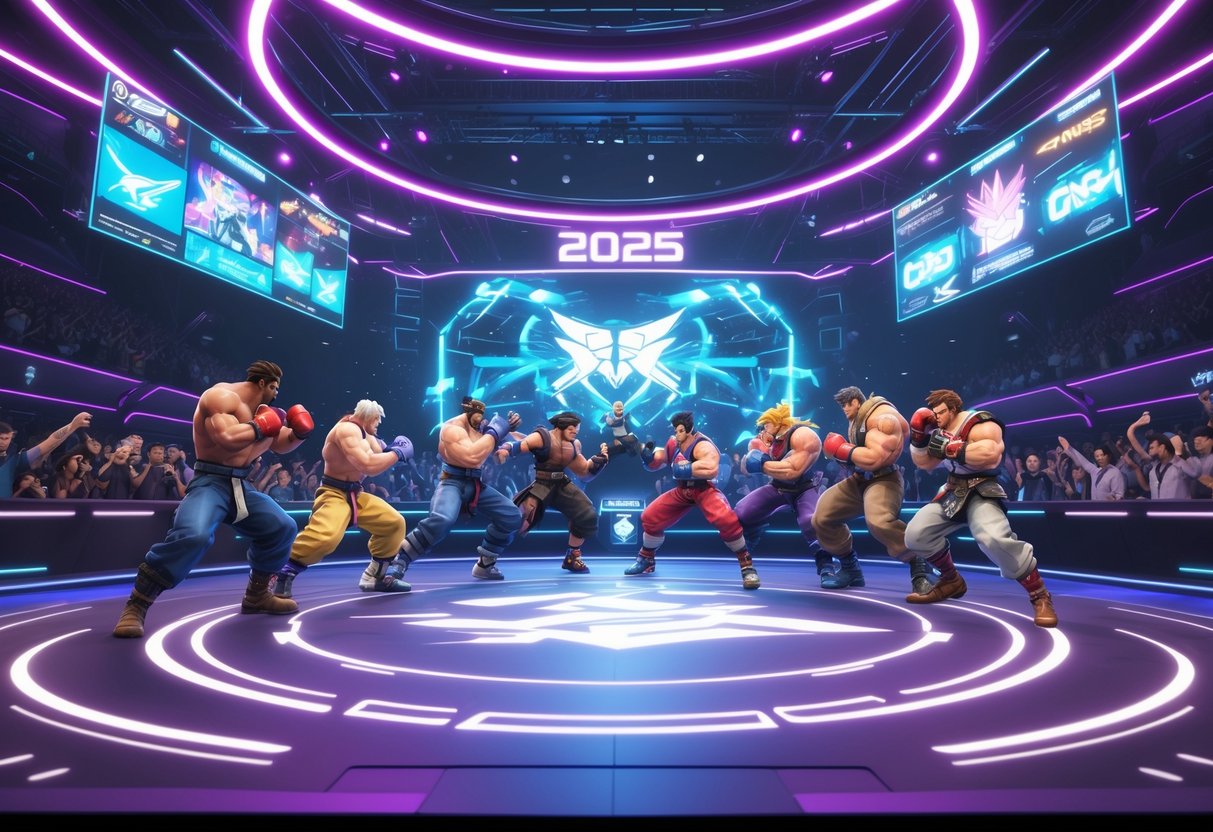
The 2025 FGC circuit showcases heavy hitters like Tekken 8 and Street Fighter 6, but there are some exciting newcomers too—Fatal Fury: City of the Wolves is definitely one to watch. These games really show off how wild and varied the competitive scene has become.
Tekken 8 Tournament Presence
Tekken 8 has taken over the 3D fighting game scene in 2025. The game’s aggressive style and Heat System keep matches fast and unpredictable, which the crowds seem to love.
Key Tournament Features:
- Main stage presence at EVO 2025 (August 1-3)
- Heat System shakes up match momentum
- Aggressive playstyle gives big rewards for offense
Players have to stay on the attack, and that’s drawn in both Tekken veterans and total newcomers.
Major tournaments are seeing huge turnouts for Tekken 8 brackets. The game’s easy to watch—even if you’re new, you can follow what’s going on.
Quick win: Just watch some Tekken 8 highlights, and you’ll get why people are talking about the Heat System.
Street Fighter 6 Competitive Scene
Street Fighter 6 is still going strong in its third year, with tight mechanics and a growing player base. The Modern control scheme has opened the door for new players, but the game still has plenty of depth for veterans.
Tournament Advantages:
- Modern controls make it easier for beginners to jump in
- Drive System keeps matches interesting and strategic
- Great for spectators thanks to clear visuals
You’ll see players using both Classic and Modern controls at tournaments. Some manage to squeeze every advantage out of the Modern setup, while others stick to what they know.
Organisers love running Street Fighter 6. The game’s reliable, fun to watch, and always draws a big crowd at events like EVO 2025.
Warning: Don’t brush off Modern controls—some of the best players are winning with them.
Granblue Fantasy Versus: Rising Highlights
Granblue Fantasy Versus: Rising has built a solid spot in 2025’s tournament lineup. The simplified inputs and RPG-inspired mechanics make for a unique experience.
Distinctive Features:
- Easy combos thanks to simplified inputs
- RPG mechanics add new layers of strategy
- Anime style brings in a loyal fanbase
The game manages to stay accessible without dumbing things down. Top players are still finding deep, tricky mechanics under the surface.
Since its debut, tournament numbers have climbed. Granblue’s fanbase is helping boost viewership, too.
Quick win: If complicated inputs scare you, try Granblue’s simple controls first.
Fatal Fury: City of the Wolves Debut
Fatal Fury: City of the Wolves is finally here, making a splash at major 2025 events. SNK’s classic series is back with new mechanics but keeps that old-school vibe.
Debut Significance:
- First time at EVO has the community buzzing
- SNK legacy brings in long-time fans
- Fresh mechanics are drawing in new players
SNK’s putting real effort behind this tournament launch. Early results look promising for the game’s future.
Players seem really happy with how it balances classic Fatal Fury with new ideas. Organisers have reported strong pre-registration for the debut brackets.
Next step: Keep an eye on Fatal Fury results to see how the meta shapes up.
Major FGC Tournament Events
The 2025 FGC calendar is just packed. Legendary tournaments bring the best players from around the world. Evo is still the big one, but CEO and Combo Breaker have carved out their own must-attend experiences.
Evo 2025
Evo 2025 ran from August 1-3 at the Las Vegas Convention Centre, holding onto its title as the most prestigious fighting game event. This year, 8,541 competitors showed up for 15 main tournaments and 20 side events.
Street Fighter 6 led the pack with 4,228 entrants. The main arena also featured Tekken 8, Fatal Fury: City of the Wolves, and Guilty Gear Strive, among others.
Organisers used a pools-to-bracket format to keep things moving. Sony Interactive Entertainment set up nine streams at once, so viewers didn’t miss a thing from pools to grand finals.
Main Arena Games:
- Street Fighter 6 (4,228 entrants)
- Tekken 8
- Fatal Fury: City of the Wolves
- Guilty Gear Strive
- Granblue Fantasy Versus: Rising
- Marvel vs. Capcom 2
- Under Night In-Birth II
- Mortal Kombat 1 (377 entrants)
Some folks worried about travel costs and visas, but Evo still drew huge crowds and kept its reputation as the ultimate FGC pilgrimage.
CEO 2025
CEO 2025 shook things up by adding the Brawlhalla Mid-Season Championship. Platform fighters don’t usually get the spotlight at FGC events, so this was a big deal.
The Florida event mixes big-name franchises with up-and-coming games. CEO’s chill vibe is a nice break from Evo’s intensity, which probably explains its popularity with both players and fans.
We’ve watched CEO become a place where new formats get tested. The 2025 edition had top-tier competition, but the laid-back, community-first approach stayed front and center.
Organisers put a lot of effort into making things inclusive. Side events and casual gaming spaces gave everyone something to do, even if they weren’t in the main brackets.
Combo Breaker 2025
Combo Breaker has become the Midwest’s top fighting game event. The tournament brings in international talent and still manages to support grassroots players.
Why Combo Breaker stands out:
- Big focus on anime fighters
- Great venue setup
- Loads of community-run side tournaments
- Mix of classic and new games
You’ll find coverage for niche titles alongside the big names. Attendance and stream numbers keep going up every year.
Combo Breaker’s schedule lets players enter more than one game, which is a huge plus for those who like to compete in a bunch of brackets.
The Midwest location makes it more affordable for players who can’t swing the costs of coastal events. Entry fees are also pretty reasonable.
Esports World Cup 2025 and Fighting Games
The Esports World Cup 2025 is putting three fighting games front and center, with a prize pool that’s honestly massive. Street Fighter 6, Tekken 8, and Fatal Fury: City of the Wolves all hit Riyadh from July 7 to August 24, with new qualifying paths and global club standings that kind of shake up how FGC tournaments usually work.
Qualifying Paths for FGC Titles
Each fighting game at the Esports World Cup takes a different route to qualification. Street Fighter 6 uses a points system from Capcom Pro Tour events during 2025.
Tekken 8 players qualify by winning regional championships and online qualifiers. The system rewards players who consistently perform, not just those who win a single big event.
Fatal Fury: City of the Wolves is the newcomer. SNK teamed up with EWC to run special qualifiers in Asia, Europe, and North America.
Regional slots break down like this:
| Region | SF6 Slots | Tekken 8 Slots | Fatal Fury Slots |
|---|---|---|---|
| Asia-Pacific | 8 | 10 | 6 |
| Europe | 6 | 6 | 4 |
| North America | 6 | 6 | 4 |
| Middle East/Africa | 4 | 4 | 2 |
Online qualifiers run from May through June 2025. Registration is £25 per player, but established pros get in free.
Format and Global Impact
The Esports World Cup sticks with a double elimination bracket for all three fighting games. Each title gets its own stage time at the venue.
Tournament matches are spread out over seven weeks. This longer format gives room for more exhibition matches and community events, which you just don’t get at most three-day majors.
Prize money heavily favors the winners—about 40% of each game’s prize pool goes to first place, with the rest split among the top 16.
Global streaming partners are covering the event in multiple languages. Viewership should easily beat regular FGC tournaments, thanks to the Saudi investment and all the extra promotion.
The long event window makes it easier for international fans to plan a trip. Visa applications opened up in March 2025 for players and spectators.
Notable Club Standings
The Club Championship system brings team-based scoring into what’s usually an individual FGC scene. Esports organizations now sign FGC players to rack up points across several fighting games.
Points allocation focuses on rewarding consistency, not just one-off wins:
- Tournament victory: 1000 points
- Runner-up: 750 points
- Top 4: 500 points
- Top 8: 250 points
Big names like Team Liquid, TSM, and Gen.G have brought top FGC players onboard specifically for EWC club standings. Now, players compete for themselves but also carry their team’s banner, which makes for some interesting situations.
Club bonuses add extra prize money for teams with multiple top finishers. Teams walk away with up to £50,000 in bonus payments—on top of what individual players win.
This system pushes organizations to build rosters across games. Instead of focusing on just one title, they sign specialists for Street Fighter 6, Tekken 8, and Fatal Fury.
Regional and Community-Driven FGC Circuits
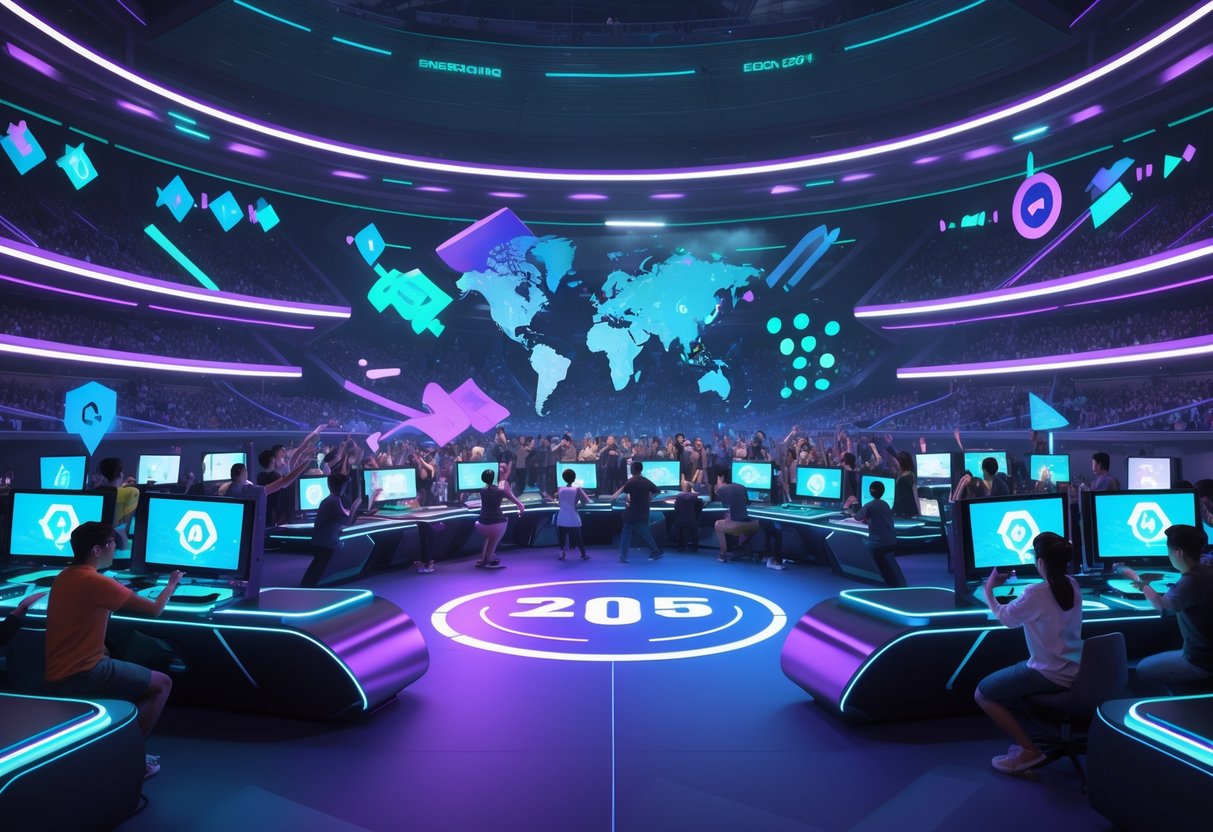
Regional circuits really keep the FGC alive. Grassroots tournaments give players a way up from local venues to the big stage.
These community-driven events keep the open, welcoming vibe that fighting game culture is known for—across every continent.
North American Tournaments
The U.S. leads the way with over 315 local FGC tournaments. Major events like Combo Breaker 2025 included World Tour qualifiers, EWC 2025 tournaments, and even some character reveals.
Beast In The East 8 made a big splash in 2025. They expanded their lineup and drew players from all over the East Coast.
Canada and Mexico keep the scene busy with dozens of weekly and monthly events. Some are small arcade meetups, others turn into multi-day championships.
The community actively tracks local tournaments with a shared spreadsheet. It’s a great way for players to find nearby events and connect with other scenes.
Quick win: Before you travel, check UltraDavid’s spreadsheet for the closest FGC local.
European FGC Events
European circuits look different because of the travel costs and country borders. Usually, each country runs its own championship series before sending players to bigger continental events.
The UK scene mainly happens in London and Manchester, with regular tournaments that feed into bigger qualifiers. France and Germany both have strong regional circuits for Street Fighter 6 and Tekken 8.
Nordic countries work together more closely, sharing players and resources. This has created a sub-regional identity in European FGC.
Eastern European scenes have exploded lately. Poland and Czech Republic now host some of the hottest new tournaments, often with lower entry fees but still high competitive standards.
Asia-Pacific Regional Highlights
Japan still leads the way for fighting games, with arcade culture fueling daily competition. Weekly tournaments in Tokyo and Osaka often feature future champions.
South Korea’s FGC leans heavily into Tekken events. The Korean Tekken Federation organizes leagues that feed into international play.
Southeast Asian countries, especially Thailand and the Philippines, now host important regional qualifiers. These events decide who’ll represent the region on the global stage.
Australia and New Zealand manage to run trans-Tasman tournaments, even with the distance. Their isolation has built tight-knit communities that compete well internationally.
China’s FGC scene is growing fast. Heavy investment in esports infrastructure has created professional-level regional circuits.
Tournament Formats and Competitive Structure
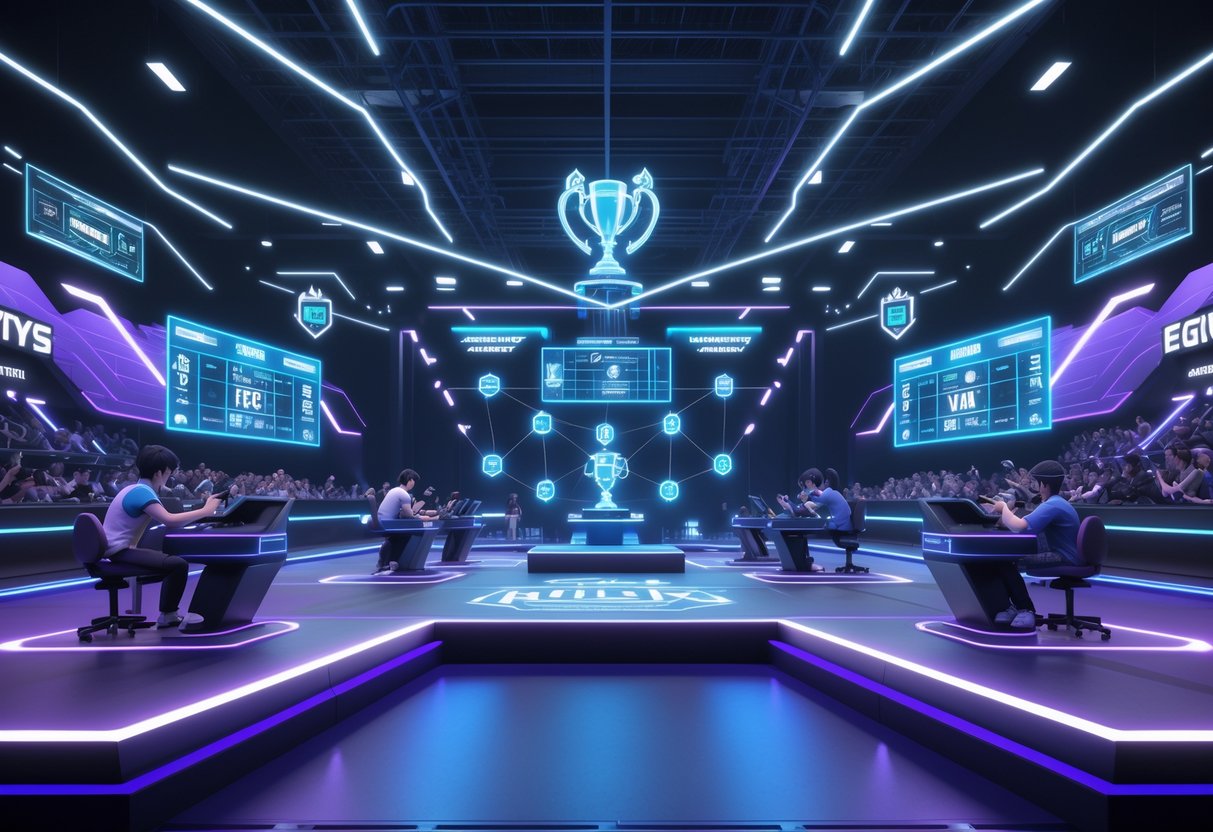
Fighting game tournaments usually use double elimination brackets with best-of-three or best-of-five matches. Prize pools and qualification systems give players a clear path to the majors.
Most tournaments hand out points for yearly rankings and championship qualification.
Bracket Systems and Seeding
Double elimination is still the go-to format for fighting game tournaments in 2025. Players get two chances—if they lose once, they drop into the “losers bracket.”
Match formats change as tournaments progress:
- Pool play: Best-of-three matches
- Top 32 and up: Best-of-five matches
- Grand finals: Extended sets (winner’s bracket finalist gets one set advantage)
Seeding decides where players land in the bracket, based on past results and ranking points. The top players get better spots to avoid early clashes with other favorites.
Some big events use Swiss format during pools. Players face others with similar records, which helps avoid bad luck with early draws.
Tournament organizers usually cap entries at 512-1024 players for practical reasons. Late registration often closes a day or two before the event.
Prize Pools and Points Distribution
Prize money can swing wildly between locals and majors. Weekly locals might put up £50-200, while something like EVO can hit £100,000+ for a single game.
Typical prize breakdown:
- 1st place: 40-50% of the pool
- 2nd place: 20-25%
- 3rd place: 12-15%
- 4th-8th place: 3-5% each
Crowdfunding often boosts prize pools. Entry fees go right into payouts, and venues just take a small cut for costs.
Circuit points matter just as much as cash. Major tournaments give winners 100+ points, while smaller events might give 10-50. These rankings affect seeding at championships and sometimes grant automatic spots.
Qualification for Finals
In 2025, players qualify for championships in a few ways. Circuit points from approved tournaments are the main route—top point earners get auto spots.
Regional qualifiers give more players a chance. Players compete in their own regions for a handful of championship slots. Online qualifiers are now more common, lowering travel barriers.
Typical qualification numbers:
- Top 16 global points leaders
- 4-8 regional qualifier winners per continent
- 2-4 wildcard spots from last-chance qualifiers
Some games use seasonal formats, with quarterly championships leading up to the yearly finals. Players need to stay consistent, not just win once.
Last-chance qualifiers take place right before the big events. These are intense, with skilled players fighting for the final spots after missing earlier chances.
Key Players and Rising Stars in 2025
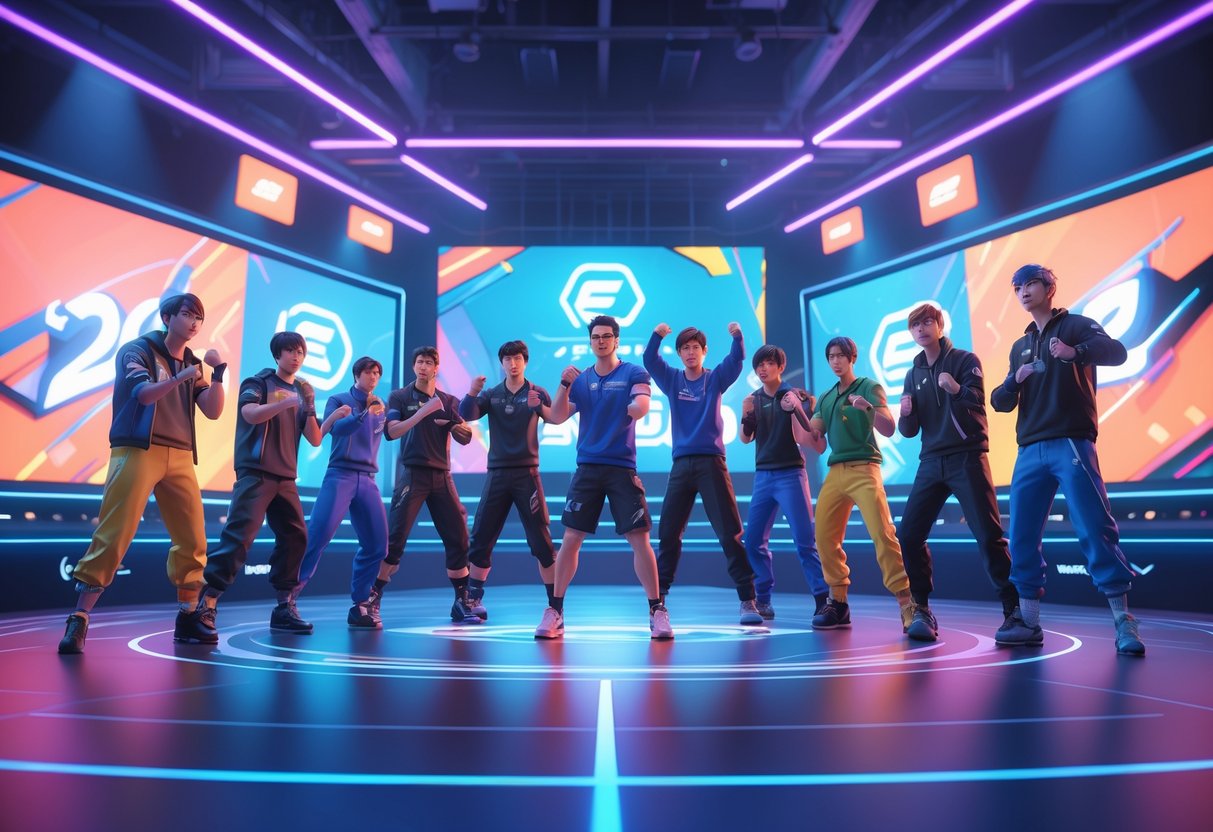
The 2025 FGC circuit has been packed with standout performances across several games. Champions like Leshar and ATIF have dominated, but new faces keep popping up at regionals.
Notable Champions and Esports Teams
Some players have really made their mark this year. Leshar took the Street Fighter 6 title at CEO 2025, locking in his spot for Capcom Cup 12. He showed that veterans can still adapt to new game updates.
ATIF crushed it in TEKKEN 8 at the same event. He picked up 560 TWT 2025 points, making himself one of the top contenders for the season.
Xiaohai won the CEO 2025 title for Fatal Fury. His deep SNK experience gave him an edge in the early City of the Wolves meta.
Kshuewhatdamoo surprised a lot of people by taking Guilty Gear Strive at CEO. They earned 200 Arc World Tour points, even though the character Unika had just joined the roster.
Team representation is bigger than ever this year. Most top players now compete under established esports orgs, which gives them way better support and training resources than before.
Rising Talents in the Circuit
New names keep breaking through. Onlinecale213 grabbed the Mortal Kombat 1 championship at CEO 2025, showing that local talent can shine when international stars focus elsewhere.
In Brawlhalla, lores won both singles and doubles. Their all-around performance proves how deep the skill pool is in platform fighters.
Regional qualifiers are now a launchpad for unknowns. More players use smaller events to gain experience before heading to the majors.
We’re seeing more folks switch between different fighting games successfully. This flexibility is a must, especially now that the FGC calendar has so many overlapping titles.
The gap between veterans and newcomers is shrinking. Better training tools and online practice let rising stars catch up faster than ever.
Streaming and Broadcasts of FGC Tournaments
Fighting game tournaments reach millions by streaming on dedicated platforms and through pro broadcast coverage. Major events like Evo run multi-channel streams on Twitch, while smaller tournaments often use several platforms to reach more fans.
Twitch Coverage and Online Viewership
Twitch is still the main spot for most fighting game tournament streams. The official Evo channel shows main stage matches, and side channels cover pools and other games.
Major tournaments go for a multi-stream setup. Evo 2025 had eight main channels at once, so you could pick your favorite game and not miss a thing.
Viewership numbers can be all over the place:
- Street Fighter 6 and Tekken 8 usually pull 50,000+ viewers
- Guilty Gear Strive and Mortal Kombat 1 get 20,000-30,000
- Anime fighters like Under Night In-Birth II bring in 5,000-15,000 dedicated fans
Most tournaments now upload VODs (Video on Demand) right after matches end. International fans really rely on these to catch up.
Organizers often add extra commentary tracks and behind-the-scenes stuff during breaks, which helps keep viewers interested through those long event days.
Partnered Streaming Platforms
FGC tournaments are teaming up with more platforms than just Twitch. YouTube Gaming streams major events at the same time, which is great for mobile viewers.
Regional events often go live on local platforms. In Asia, you’ll find tournaments on NicoNico or Bilibili for Japanese and Chinese audiences.
Most platform partnerships look like this:
- Twitch for live coverage
- YouTube for VODs
- Regional platforms for local fans
- Social media for highlights and promos
Some events try exclusive deals, but most stick to multi-platform streaming to reach as many people as possible and not split up their community.
Tampa Never Sleeps, which runs over 300 online tournaments a year, uses this approach to serve thousands of players across different regions and preferences.
Community and Industry Involvement
The FGC tournament circuit depends on passionate volunteers and a lively vendor community. These groups make events run smoothly and keep the atmosphere fun and welcoming.
Volunteer and Staff Roles
Volunteers keep most FGC tournaments running in 2025. Organizers usually need 20-50 volunteers for big events like CEO or EVO.
Stream technicians set up broadcasts and make sure matches reach viewers online. A lot of them start as general volunteers and pick up technical skills as they go.
Bracket runners handle player check-ins and keep tournament software updated in real time. It’s a great way to learn tournament structure and stay close to the action.
Commentary assistants help casters by providing stats and match notes. If you want to get into commentary, this is a solid first step.
Most volunteer gigs come with free entry and meals. The biggest tournaments, like EVO, also hand out volunteer t-shirts and networking opportunities with industry pros.
Heads up: Some events have issues with volunteer coordination. Always double-check your role and contact info before traveling to a tournament.
Artists and Vendors at Events
The vendor scene has blown up at FGC events in 2025. Artists bring custom controller art, character prints, and tournament merchandise straight to fans.
Arcade stick modders are still a huge hit. They’ll deck out controllers with anime art, LED lighting, and top-tier parts. Most custom jobs go for £150-400.
Apparel vendors show up with team jerseys, meme tees, and game-inspired gear. A lot of FGC clothing brands started out as tiny booths at tournaments.
Food trucks and local restaurants get in on the action too. They team up with venues to keep competitors fed. Events like CEO really hype up Orlando’s local businesses right alongside the gaming vendors.
Quick win: Follow your favorite FGC artists on social media before the event. They’ll often announce exclusive prints or offer pre-order discounts for booth pickup.
This vendor economy keeps tournaments afloat and gives fans access to unique merch they’d never find anywhere else.
Future Outlook for the FGC Tournament Circuit
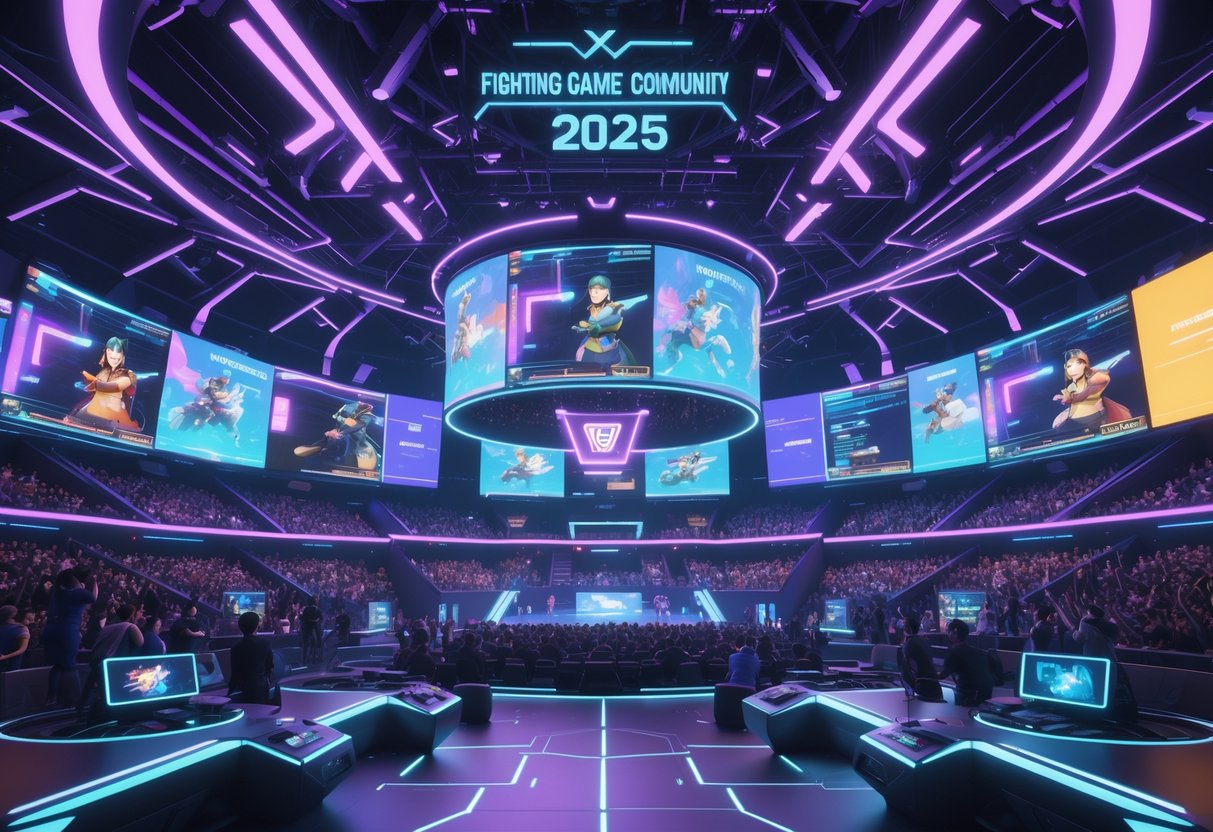
The fighting game community faces a real turning point in 2025. New titles are shaking things up, while older games might need rule changes to stay relevant.
Several big trends will drive how tournaments run and grow over the next year.
Upcoming Trends and Titles
2XKO is about to flip the script for fighting games. Riot Games plans to launch their League of Legends-inspired fighter in summer 2025.
Riot brings their proven esports infrastructure into the FGC. Expect structured seasons, big prize pools, and involvement from major organizations right out of the gate.
That’s a big shift from the usual fighting game launch. Most games have to claw their way up to a competitive scene. 2XKO gets a head start with built-in marketing and tournament systems.
Traditional games are feeling the pressure. Street Fighter 6 and Tekken 8 now have to compete with Riot’s marketing machine. Capcom and Bandai Namco are both adding accessibility features to bring in fresh players.
The tag-team format in 2XKO might set off a trend. Two-versus-two play means tournaments need new structures and team dynamics instead of just the classic one-on-one fights.
Regional expansion is still rolling. More countries send players to big finals now, which brings new fans and playstyles to the scene.
Potential Rule Changes for 2026
Tournament formats could move towards more team-based play. If 2XKO takes off, other games might try out crew battles or tag formats.
Right now, most FGC events focus on solo competition. Team formats could open up more sponsorships and attract bigger audiences.
Prize pool distribution is still a sticking point. Lots of tournaments pay out less than other esports. Developers are trying circuit points and season-long competitions to boost interest.
Regional qualifying is spreading out. More events now feed into global championships, giving international players a clearer path.
Accessibility rules for controller mods and input methods are a hot topic. Street Fighter 6’s Modern Controls started debates about keeping things fair versus making the game open to everyone.
The FGC has to walk a fine line between tradition and growth as new players and games show up.
Resources and Further Information
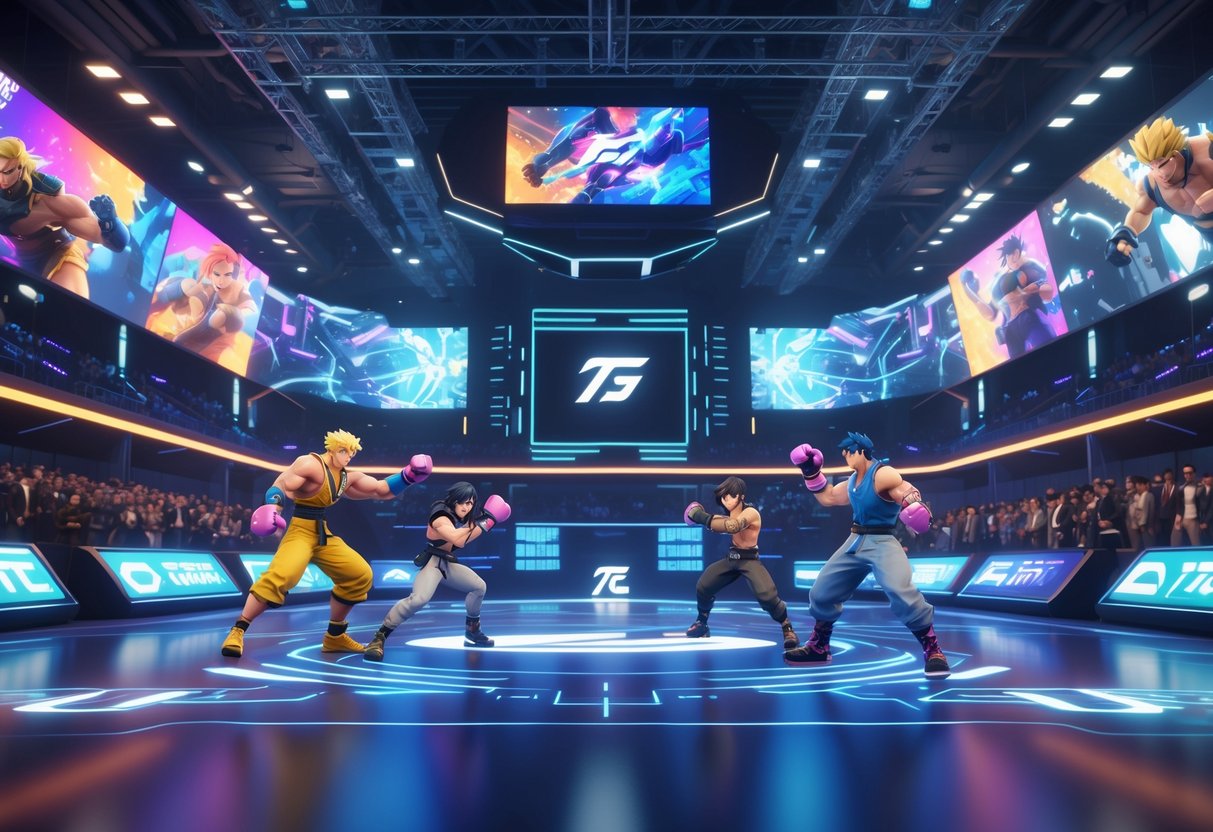
Finding up-to-date tournament schedules and event listings is pretty much essential if you want to keep up with the FGC in 2025. Official tournament sites and specialized calendar platforms usually have the most accurate dates and sign-up info.
Official Tournament Schedules
Official tournament websites post the most trustworthy info for major FGC events. Evo’s site lists full schedules, game lineups, and registration for both Las Vegas and regional events like Evo Japan.
Combo Breaker keeps a detailed schedule on their site. You’ll find World Tour qualifiers and EWC 2025 events happening at their May tournament.
The Capcom Cup site covers their $1 million tournament in detail. You’ll get bracket info, qualification rules, and Street Fighter League championship updates.
Arc System Works hosts the ARC World Tour finals site. That covers Guilty Gear Strive, Granblue Fantasy Versus Rising, and Melty Blood events set for March in LA.
Quick tip: Bookmark these official sites. They update months ahead of each event.
FGC Calendar and Event Listings
Liquipedia Fighting Games Wiki is the go-to tournament database. Check there first for full event schedules, results, and team lists across all the big games.
DashFight has a great tournament calendar with filters. Sort by game, region, or date to find events that fit your interests. They also drop VODs and match reviews after tournaments.
FGC Colosseum posts updated schedules with local time zone conversions. That’s a lifesaver if you’re tracking events in other regions.
Warning: Always double-check dates on official tournament sites before making travel plans. Schedules can and do change.
Frequently Asked Questions
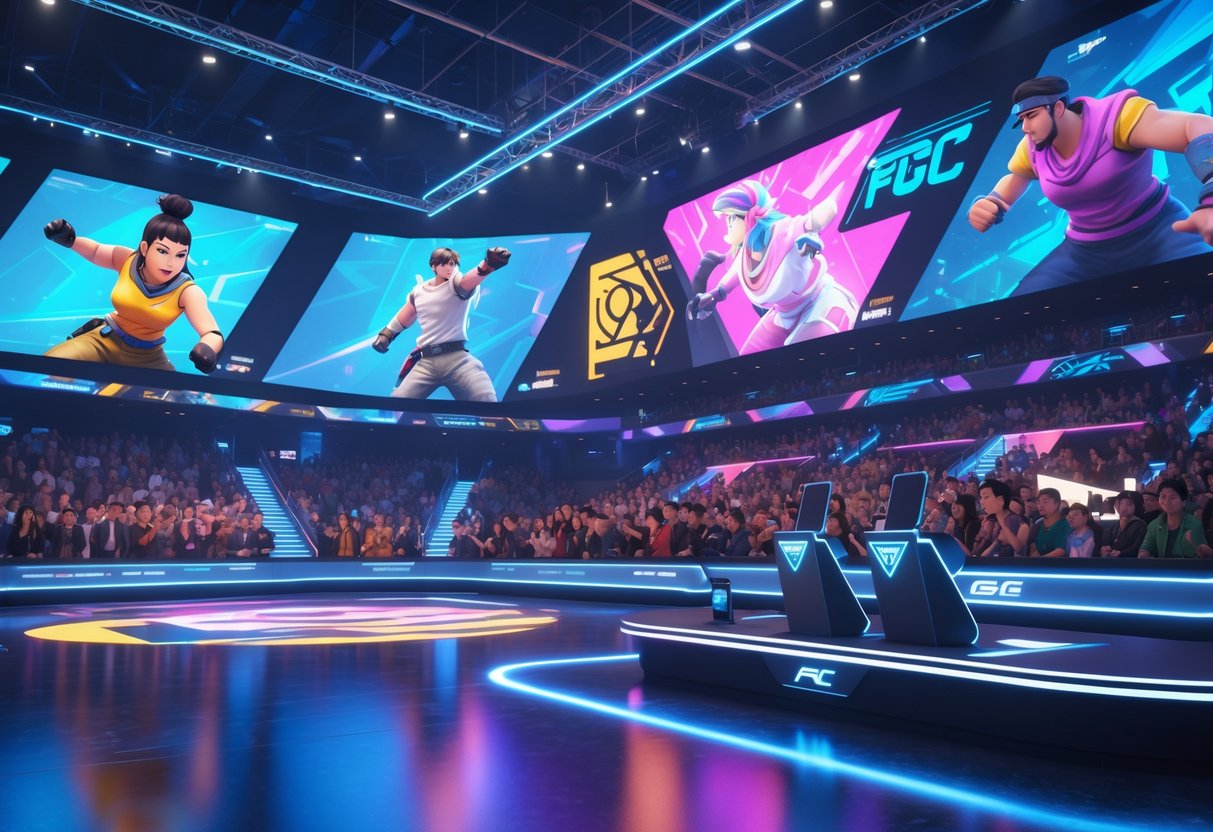
The FGC tournament circuit can feel like a maze, with tons of major events on every continent. Here’s what you need to know about the biggest fighting game tournaments in 2025.
What are the dates for Combo Breaker 2025?
Combo Breaker 2025 runs from May 23 to May 25. You’ll see over 20 fighting games with World Tour qualifiers for seven top titles.
The main finals all happen Sunday, May 25. Street Fighter 6 top 8 kicks off at 7:30 PM local time.
TEKKEN 8 and KOF XV both get going at 4:30 PM. Mortal Kombat 1 wraps up on Saturday night at 7 PM, so players have time to rest before Sunday’s action.
How can I register for EVO 2025 and what’s the deadline?
EVO 2025 is set for August 1st to 3rd at the Las Vegas Convention Center. Registration usually opens about 3-4 months before the event on the official EVO site.
It’s smart to register early—popular games like Street Fighter 6 and TEKKEN 8 fill up fast. Hotels near the venue book out quickly, too.
Entry fees are usually £25-40 per title. Spectator passes cost about £35 for the weekend.
Which cities will host the major FGC tournaments in 2025?
Las Vegas is still the main stage, with EVO 2025 at the Convention Center. Chicago gets Combo Breaker 2025, which is a key World Tour event.
CEO 2025 bounces around but lands at the Rosen Shingle Creek in Orlando, with over 1,000 hotel rooms booked for the event.
Brussels hosted the Challenge Major Edition earlier this year. Panama City will run the FIRST Global Challenge from October 29 to November 1, bringing together students from over 190 countries for STEM-focused competitions.
Are there any newcomer-friendly events at CEO 2025 FGC?
CEO 2025 at Rosen Shingle Creek really leans into community celebration, not just the hardcore competition. Spectators and casual fans are totally welcome.
Most FGC tournaments offer beginner brackets and casual gaming zones. These give new players a chance to soak up the tournament vibe without jumping straight into the deep end.
We’d suggest checking CEO 2025’s official schedule closer to the event. Major tournaments usually announce newcomer activities and side events separately from the main brackets.
What is the schedule for Tekken 8 tournaments in 2025?
TEKKEN World Tour 2025 started at EVO Japan, where Knee took the win. Combo Breaker 2025 has another big qualifier on May 25 at 4:30 PM local time.
The tour runs several Platinum and Gold tier events throughout the year. Each event gives out different points toward TWT 2025 Finals qualification.
Esports World Cup 2025 also hosts separate TEKKEN 8 qualifiers. Four players—EDGE, Arslan Ash, Rangchu, and LowHigh—qualified at Combo Breaker.
Where can I find the results of the most recent FGC tournaments?
Liquipedia Fighting Games Wiki keeps up with tournament results for all the big titles.
You’ll find schedules, brackets, and final placements for every major event there.
Most individual tournament websites post results just a few hours after things wrap up.
For example, when Combo Breaker 2025 ended, you could see UMISHO taking Guilty Gear Strive and Mulgold winning TEKKEN 8.
Social media’s also pretty handy—major tournament series like @ComboBreaker, @EVO, and @CEOGaming share updates as the action happens.
If you want real-time results and quick announcements, following those accounts is your best bet.

